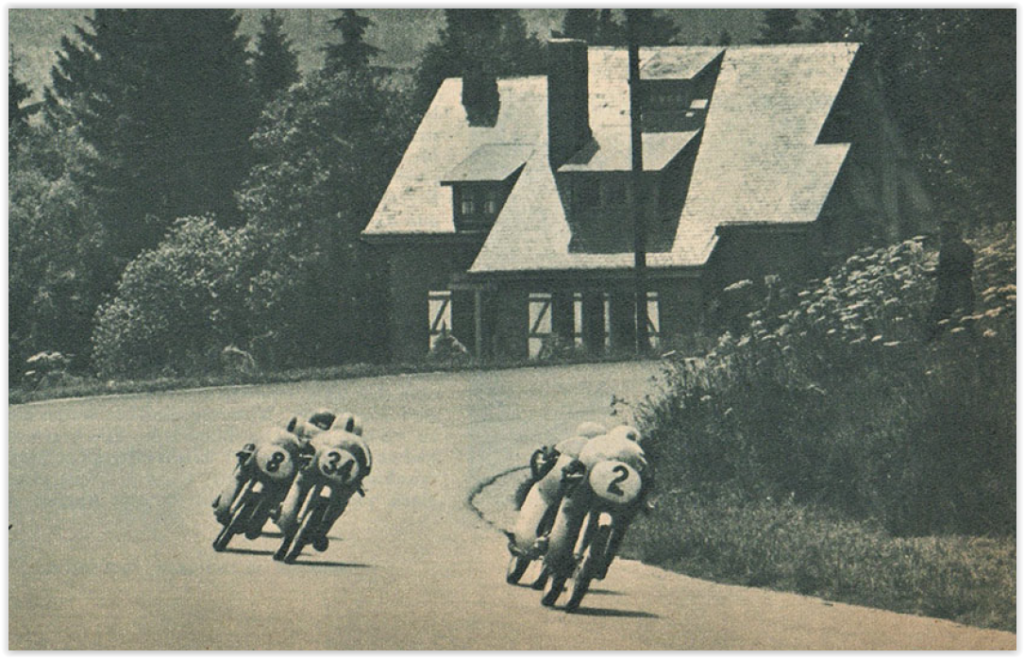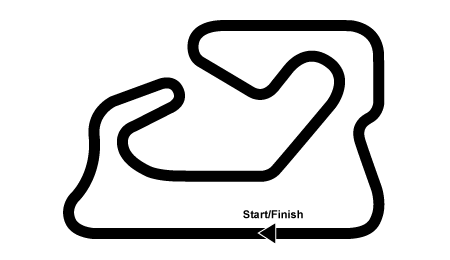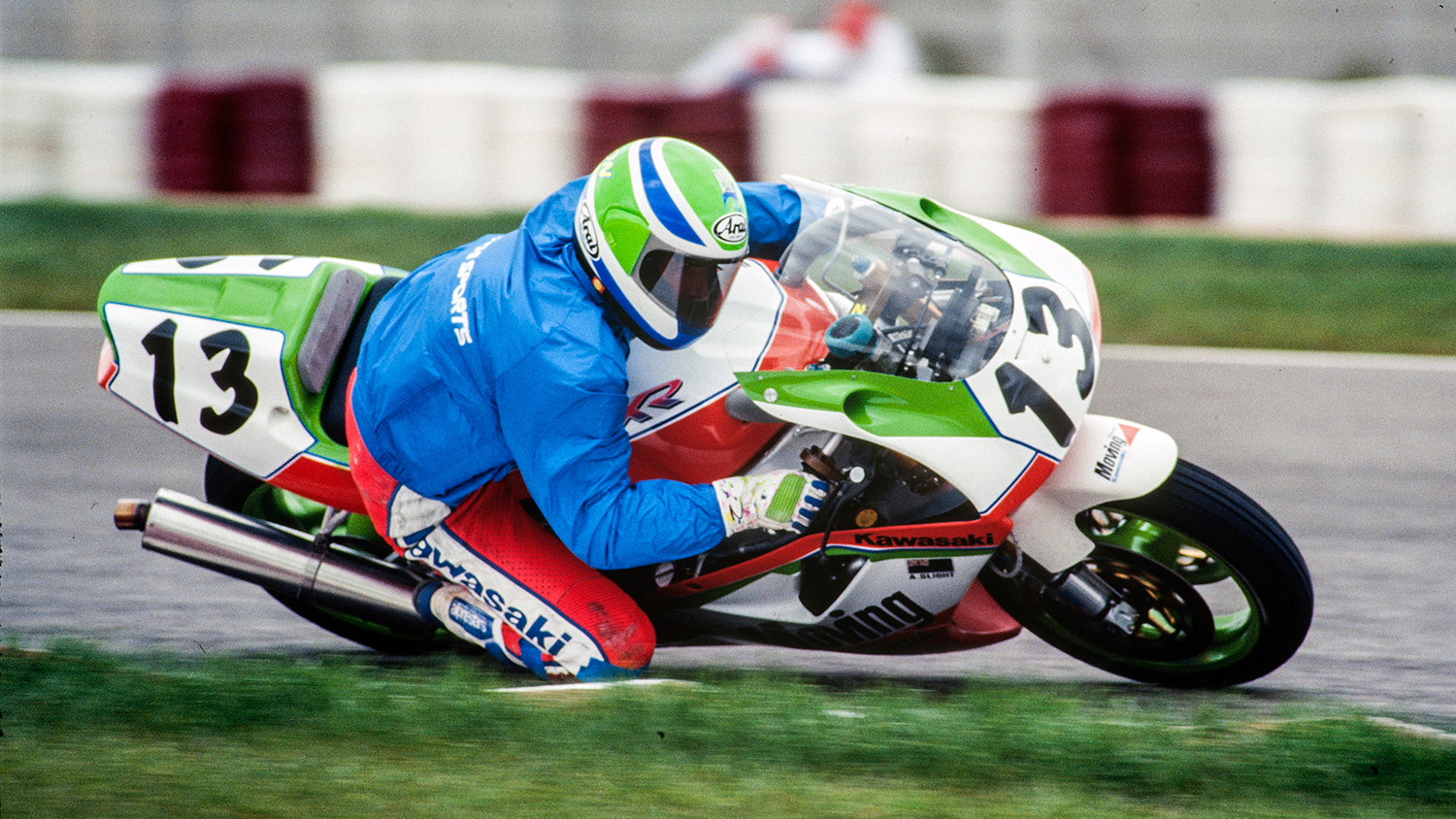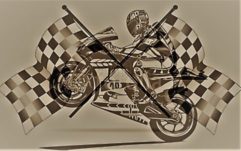
The first half of the 1992 season – the 5th year of the WorldSBK
The 1990 world champion Raymond Roche had to relinquish his place in the Ducati factory team to the newcomer from the USA after his significant defeat. Therefore, he had founded the team Raymond Roche Ducati, with which he tried on a private basis to get back the title lost in 1991 to Doug Polen. As vice world champion, the search for sponsors was, fortunately, a manageable task at the time. The World Cup third Rob Phillis started with the Moving Kawasaki team in 1992. With that, the Australian again competed in green, as many at the time found a color that definitely suited him.

The calendar for the 1992 season
Mosport in Canada has not been on the calendar since the 1991 boycott. After all the top drivers, including the US-Americans involved in the World Championship fight, showed their solidarity and had not even arrived, the FIM finally decided not to use this highly dangerous route.

With Albacete, Spa-Francorchamps, Johor Bahru and Assen, four new courses were on the calendar, of which Spa in Belgium and the “Cathedral of Speed” in the neighboring country of tulips and cyclists were already well known in the motorsport world. As in the first three years of the Superbike World Championship, the final was planned again in Manfeild (New Zealand) after a break in the previous year. For the first time, two World Championship races were announced in one season in Italy and now also in Spain. Below are the racetracks in the calendar with the exact dates and previous records before the start of the 1992 season, if available and not new.



Start of the 1992 season – the second time in Spain

The start of the season in Spain in spring made perfect sense
So far, the new year had been rung in three times in Donington and in 1990, exceptionally, in Jerez. This time we went to Valencia, a little further south from Albacete, where it is usually much warmer in spring than in England. After all, in 1992 there were nine of 13 World Championship races that were part of the European Championship. This meant that the drivers from the old continent had one more run than last year. The following is an excerpt from the entry list for the first race of the season in Spain, which included no fewer than 73 drivers.

The first race of the season
Aaron Slight had been signed by Kawasaki for the entire 1992 season after some notable successes in the previous year at the races in Sugo, Malaysia and Australia. The Kiwi had already got two top ten results in Australia two years ago and a podium place in his home country. With his victory in the first race of 1992 on the Albacete track, which was new for all drivers, he immediately proved to be a good investment for his Moving Kawasaki team. Second place went to the reigning world champion Doug Polen (Ducati) ahead of Fabrizio Pirovano (Yamaha), Giancarlo Falappa (Ducati) and Daniel Amatriain as the best Spaniard on a Ducati. Vice world champion Raymond Roche on his private Ducati was only seventh behind Rumi Honda rider Baldassare Monti. The Japanese Takahiro Sohwa, Rob Phillis (both Kawasaki) and local hero Juan Manuel López Mella on Nivea Honda completed the top ten.


The second run of Albacete
After the first race had already taken place in the wet, the track was still damp in the second race, but at least it wasn’t raining anymore. Aaron Slight crashed on the seventh lap and with lap times that were around 6 seconds faster, there was a blink of an eye final, as is often the case during this time. Roche won razor-thin ahead of Rob Phillis and Amatriain, who had set the fastest lap with two laps to go. Pirovano was fourth ahead of Falappa and Polen. The top ten were completed by the three Kawasakis riders Scott Russell (USA), John Reynolds and Terry Rymer (both GBR) in front of Carl Fogarty on Ducati. A total of 10 drivers did not see the checkered flag in this run and two did not start at all.


Round 2 at Donington Park

Stépane Mertens in particular was one of the drivers with a bad start to the season. The Belgian, who was fourth in the World Cup last year, did not get past ranks 11 and 12 in Spain. This time it was sunny and dry in Donington. Mertens took 7th place in the first race and missed the points with P16 in the second race. Race one went to Raymond Roche ahead of Pirovano, Russell, Phillis, Slight and Polen. On the eighth lap, Carl Fogarty fell with his Ducati 888.

In the second race, the Englishman Fogarty showed his class and won a world championship round of the Superbike World Championship for the first time ahead of Roche and Russell. As a teenager, the son of amateur racing driver George was angry with his father if he didn’t get the last of his machine out of the way in order to be the best of them all. Now the son was on the way to do better from his point of view.


For the fifth time in a row at the Hockenheim-Ring

The second longest route on the calendar for this year
Roche traveled to Germany as the World Cup leader. In the World Cup he was leading with 66 points ahead of Pirovano (56), Polen (50) and Phillis (46). The 6.788 km long course at that time presented itself in sunny and dry weather and there were only 14 laps to complete per run. Until Spa-Francorchamps was added to the calendar for only one season, however, the Hockenheimring had been the longest circuit on the calendar. This time the reigning world champion and record holder was able to assert himself for the first time. Doug Poland won the first race of the young season with just over 5 seconds ahead of Rob Phillis. Behind them followed two more Kawasakis, Slight and Russell. This time Roche had to be content with 5th place ahead of Stéphane Mertens and the French Hervé Moineau on a Suzuki.


The second run at the Hockenheimring
Doug Polen took his first double victory in race two after the record season of 1991, when he had triumphed no fewer than 17 times. The Australian Phillis was again the best Kawasaki rider with 2nd place ahead of Giancarlo Falappa, Raymond Roche (both Ducati), Aaron Slight and Fabrizio Pirovano on the best Yamaha. The top ten were completed by Russell, John Reynolds, the Swiss Andreas Hofmann (all Kawasaki) and the best Suzuki with Hervé Moineau. A total of eight drivers did not see the checkered flag, including the Spaniard Daniel Amatriain and the Italian Baldassare Monti.


Round 4 – the premiere in Spa-Francorchamps

After the high-speed track at Hockenheim, the next high-speed circuit continued with Spa. Two laps later, the Österreich-Ring was another course in this category. Doug Polen had made up ground on World Cup leader Roche after his double victory in Germany and was now tied with him with 90 points in the lead. The first run was the prey of Rob Phillis, who made the podium with local hero Mertens and Scott Russell. Polen finished fifth behind Falappa and Slight crossed the finish line in 6th. Raymond Roche was eliminated on the first lap due to a crash and Fabrizio Pirovano also crashed in the penultimate round.


The second round of Spa should remain the last in Belgium
Not surprisingly, the second run was the last race that WorldSBK contested on the beautifully situated track in the Ardennes. Doug Polen won his third race of the season with the second run ahead of Falappa, Pirovano, Roche and Phillis. Local hero Mertens had to be content with 6th place ahead of Slight and Fogarty. Initially still on P3, Scott Russell fell back to 9th place by the end of the race. Before moving on to Spain again, the world champion from the USA was in the lead in the interim World Championship with 121 points for the first time. Behind Rob Phillis with their 111 and Raymond Roche with 103.


World Championship round 5 in Jarama with the 100th WSBK race

The route north-east of Madrid was the second round of the World Cup on the calendar last year. With 3.858 km (2,397 miles) again one of the shorter courses, 24 laps had to be completed here and in good weather it was dry on June 21, 1992. World Championship leader Doug Polen had terrible bad luck when his clutch collapsed two laps before the end, and he had to give up. Mertens also dropped out with a rather rare problem. With the Belgian it was the steering damper that was defective and forced him to give up after 6 laps. Another unlucky person in the first race was Pirovano with an engine defect on his Yamaha FZR-750R. The winner of the 100th anniversary race in the 5th year of the Superbike World Championship was Rob Phillis on a Kawasaki. Below is the result sheet of the first run of Jarama.


The second run of Jarama
After his unfortunate retirement in the first, Doug Polen struck in the second race and won ahead of Rob Phillis, who took the overall victory. Fabrizio Pirovano was 3rd ahead of Mertens, Slight Roche and Falappa. The top ten was completed by the Italian Fabrizio Furlan on Ducati, Christer Lindholm (Sweden, Yamaha) and Baldassare Monti on Rumi Honda. Fred Merkel, as a team-mate of the latter, fell, as did Carl Fogarty and Davide Tardozzi.


World Championship round 6 on the Österreich-Ring

The former Österreich-Ring was much more fluid than the course known today as the Red Bull Ring, which had already been disfigured as the A1-Ring in 1996. Today’s curve 1, just like the 3 and 4, can hardly be described as such, as it is more like edges today. The Superbike World Championship was on the original route, which was still 5.853 km long. The Italian Giancarlo Falappa had bad memories of the Österreich-Ring. The guardrails, which were placed much too close, almost cost him his life in a fatal crash in 1990. With 27 broken bones and a ruptured artery, his season ended prematurely and almost his life.


The incredible feat of Falappa
And what was the warrior doing in Styria in 1992? Two years after his life-threatening accident, he won one of the tightest races of the season. The fourth-placed Italian was just 0.879 seconds behind his compatriot and winner. The average of Falappa’s fastest lap back then was 188.888 kph. In MotoGP, the fastest lap to date on the Red Bull Ring by Marc Marquez in 2019 was measured with an average of 187.2 kph. Raymond Roche had retired from the first run when he suffered an engine failure on the last lap.


The second run of Spielberg
Stéphane Mertens had only come 12 laps in the first race before an oil leak meant the end for the Belgian. In the second run things went much better for him. At the finish he had to admit defeat by just 0.161 against an outstanding Giancarlo Falappa as a double winner. Roche held third place and was less than four tenths behind the winner. Rob Phillis and Doug Poland ran into the double winner within a second and even Fabrizio Pirovano in sixth was only 1.5 seconds behind the winner. This time Aaron Slight had a major engine failure with 4 laps to go. The top ten were completed by Carl Fogarty, Davide Tardozzi, Daniel Amatriain and Fred Merkel, the world champion from 1988 and 1989. Local hero Andy Meklau finished 13th in the second race.


Round 7 in Mugello

The beautifully situated racetrack in the Apennines was the setting for the last stop before the summer break, after which it was to go overseas for the first time this year. In the first run, the world championship leader was unlucky. After Fred Merkels retired on his Honda after five laps with an engine failure, the Australian Rob Phillis said goodbye to the first race with a fall at halftime. The victory went to Raymond Roche, ahead of Doug Polen, Giancarlo Falappa and Stéphane Mertens. For the numerous Tifosi who had come, it was of course exciting to cheer on 4 Ducatis in the first four places.


The second race in Mugello
Except for the change of places in positions 2 and 3, the second run was almost a copy of the first in terms of the podium. This time, however, Carl Fogarty was fourth-best Ducati in 4th place. Rob Phillis made it to 5th place at least after the bad luck in the first race. But the Australian had lost the championship lead again to Doug Polen. The Kawasaki driver was only 10 points behind, however, behind him was Raymond Roche, who was only 5 points less. With four wins, the French totaled as many as the US-American and reigning world champion Polen. The Italian warhorse Falappa followed in fourth place. After 7 of 13 rounds, his gap to the world championship leader was still manageable with 26 points.


Championship interim balance after half-time
Even if things didn’t go as perfectly for him as last year, the reigning world champion Polen was in the lead after 7 of 13 laps. Just like the 1990 world champion Raymond Roche, the world championship leader had won four of the first 14 races. The first 8 to 9 drivers in the intermediate ranking had a chance of winning the title. Including Kawasaki rookie Aaron Slight, who won the first race of the season that started in the rain. Davide Tardozzi, who finished third in the 1988 World Cup, only had theoretical chances for the title.

The second half of the 1992 season: http://www.motoracers.eu/wsbk-history-part-10/?lang=en

No Comments Yet